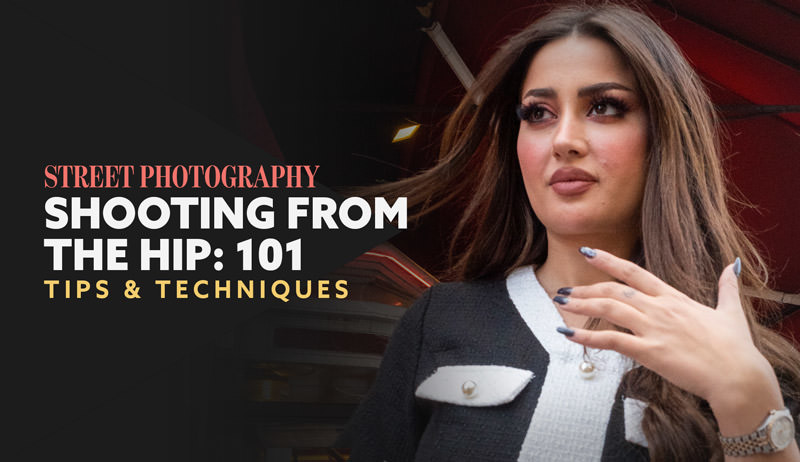
In this article, I’m going to share my basics of shooting from the hip, a fun way to get candid, up-close street photos. We’ll cover camera settings, what to look for, and other techniques along the way. Let’s get into it!
Why Shoot From the Hip?
Shooting from the hip isn’t easy, but it can be practiced and honed to increase your keepers.
This style of shooting has several benefits, but it also has some drawbacks. One of the major drawbacks is that you’re not using the viewfinder or LCD to line up your shot, so you’ll have about 80-90% bad photos. This isn’t really an issue if you don’t mind sifting through the garbage to find a gem, or you’re shooting digital and have enough storage on your computer. You’ll also have several crooked images, but just think of Garry Winogrand and his style. A great image doesn’t have to be perfectly perpendicular.

Aside from those minor drawbacks, the benefits are exciting and it’s really fun! A lot of street photographers have shy tendencies, so shooting from the hip can ease some tension and allow them to capture subjects a little closer. The chances of someone confronting you for taking a photo are slim to none. The only time you’d experience any issues is if they somehow hear a loud shutter clapping at them, or you’re being too direct when you point your camera.
Even though you’re shooting from the hip, you still have to practice incognito behaviors like pretending to talk on your phone, pretending to use your phone as GPS (I used this a lot in Paris), or turn your head the other way while you shoot. Sunglasses help with the last one! All of these methods throw off your subject and make your intentions more camouflaged.
Another great benefit of shooting from the hip is that it requires minimal effort when getting a unique perspective. If you’ve ever seen Bruce Gilden photograph in the streets, he’s up and down, up and down, bobbing and weaving all day trying to get a unique perspective. When you shoot from the hip you’re mostly just working your wrist and “trigger finger” as you walk around. We’ll cover more on unique perspectives later, but here’s a photo that looks like it was taken while squatting down, but it was from the hip with my arm to my side.
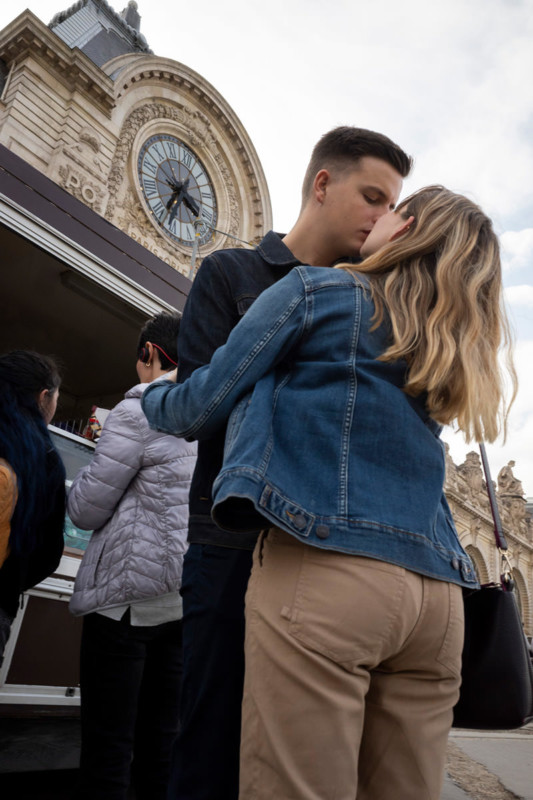
Shooting from the hip also gives you another tool to use when you need. Typically I like looking through the viewfinder or using the LCD to compose a shot like these next few photos, but you can’t do this safely and without confrontation in seedy neighborhoods or with potentially dangerous subjects.
Note: The three images to follow were composed by using the LCD. All of the photos in this article are just as they were shot; no manipulation or heavy editing, no cropping, no dodging or burning. Not to say they don’t need a little more finesse, but this is to give you an idea of what you can expect when you go out shooting from the hip for yourself.
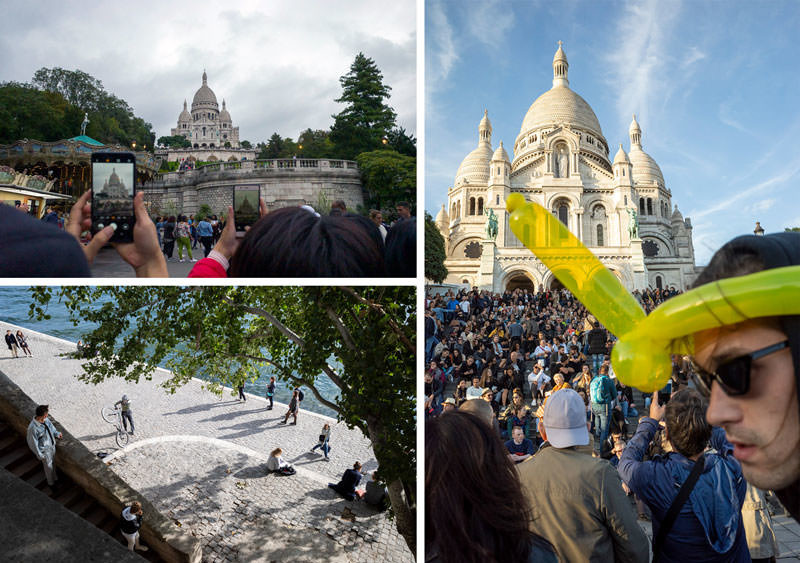
To give you an idea of the seedy neighborhoods I’m referring to, I’ll give you some details from a time when I visited Montmartre, in Paris. This is the “bohemian” neighborhood where Moulin Rouge is, alongside pubs and sex shops. I ended up in a neighborhood full of poverty and what looked like potential drug-dealing territory. If you watch enough movies and TV, you start to gather ideas of what these neighborhoods might look like; even if they are exaggerated for cinematic entertainment.
I was able to capture one subject in a sequence who I call “scarface” because of his massive scar. Would you want to ask him for a portrait or be caught taking his photo? Ok, maybe those pink Nike slippers aren’t too intimidating for most of you, but it’s probably safer to just shoot from the hip and keep moving.
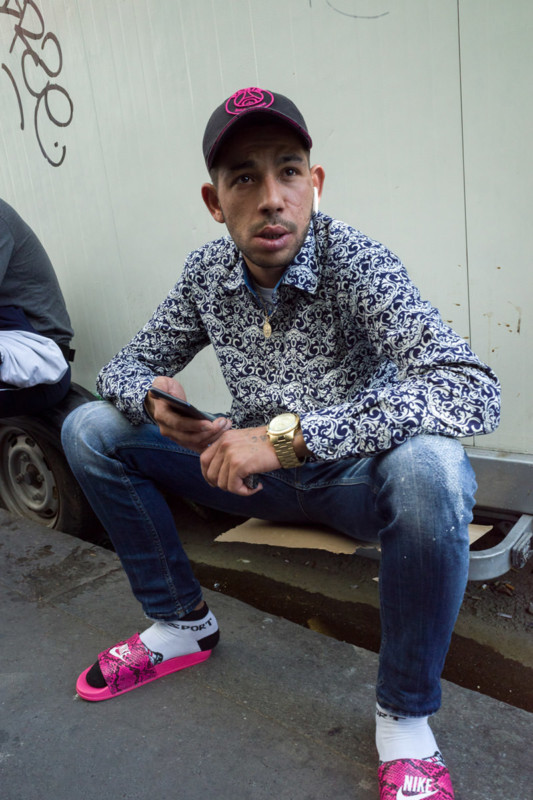
Here’s the full sequence, but we’ll cover more on that in a bit. Notice how he follows me the whole time! When I was walking around with my large DSLR and zoom lens in the safer neighborhoods of Paris, I still got the evil eye from people and they noticed my camera right away. With small cameras like the Ricoh GR III, no one seems to notice or care, thankfully.

The other photos taken in this poverty-stricken neighborhood will give you an idea of what I saw and why I shot from the hip. Here’s a guy selling “probably stolen” necklaces and watches.

Here are several more that capture the neighborhood well.
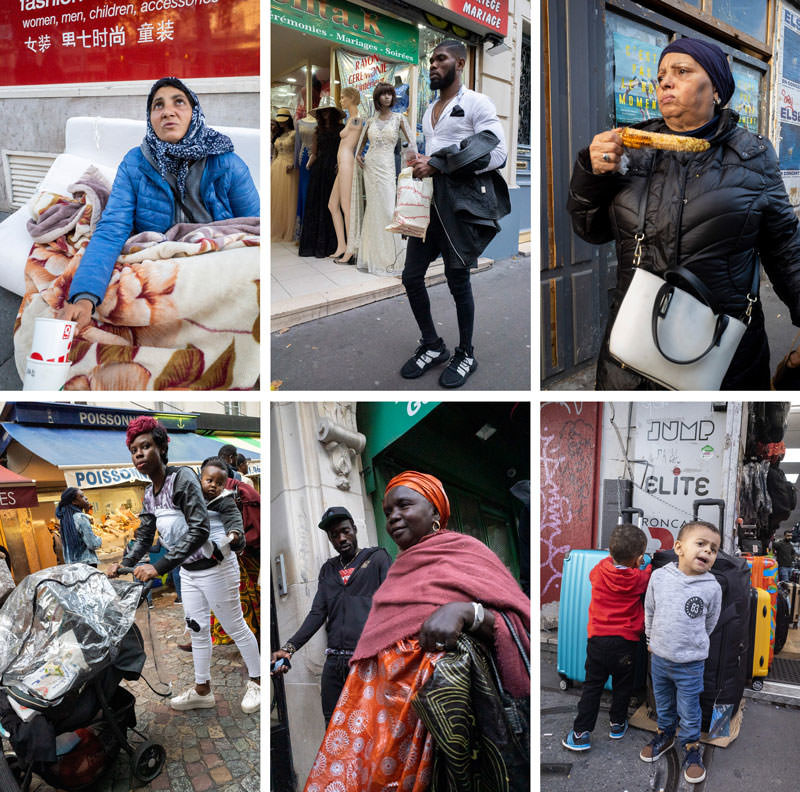
Shooting from the hip allows you to have fun with street photography without worrying about the confrontation. You can even take this technique into stores or museums. Here’s a shot of an older gentleman checking his watch in the Musee d’Orsay.
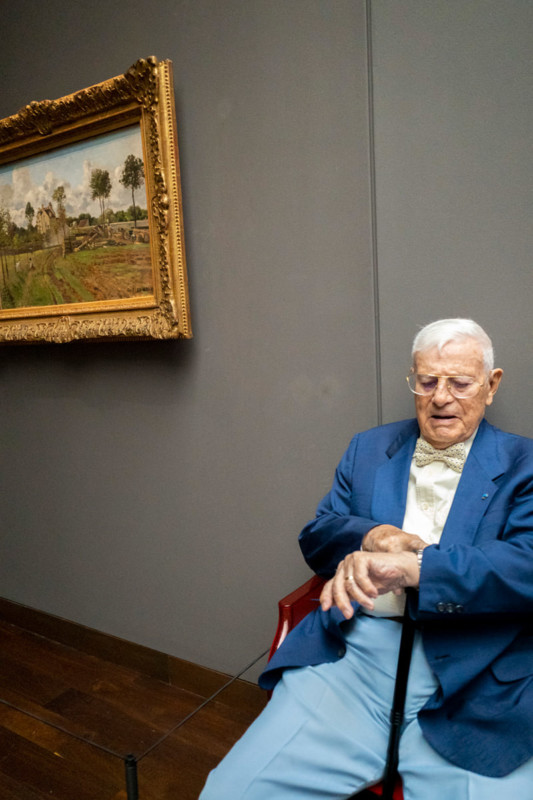
Camera and Settings
For all of the photos in this article, the Ricoh GR III was used. It has a 28mm equivalent lens, which is great for crowds or getting close to people. We can see how close I was able to get in these next photos. And since a major goal for most street photographers is to blend in, get close to the subject, remain unnoticed, and capture an authentic moment in time that wasn’t manipulated, this method of shooting from the hip works perfectly.
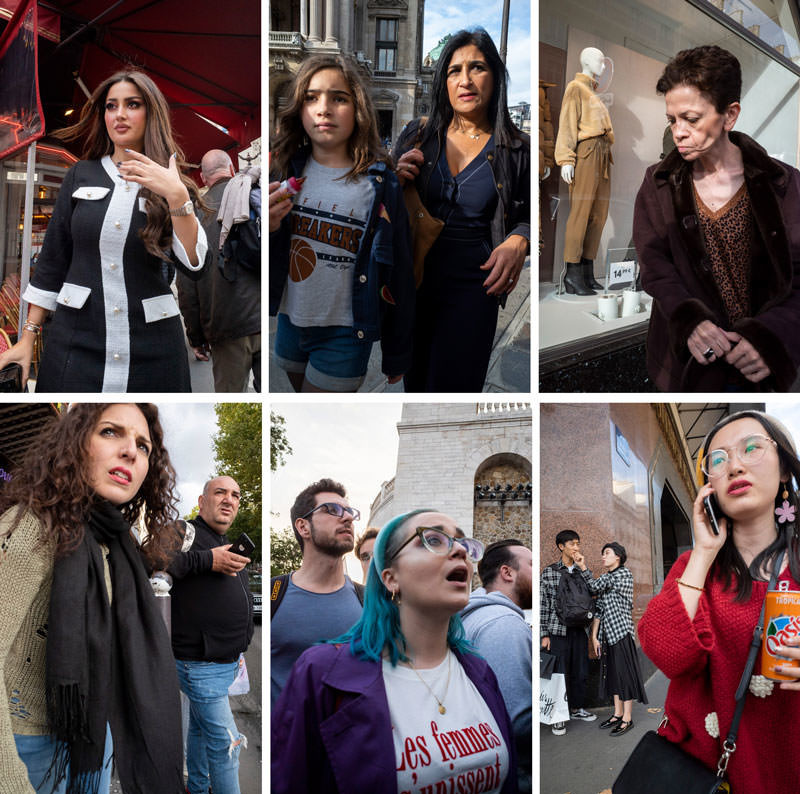
The Ricoh camera is so small that it fits in your pocket, but other cameras can be used. Just be aware that the bigger the camera and lens, the more you draw attention to yourself. Not to mention the incremental fatigue that comes with walking around with heavier equipment. If you can get away with shooting from the hip with a Canon 1DX Mark II then go for it! You’ll probably get some great photos if your arm doesn’t fall off.
Other street photographers sit in the shadows and wait for subjects to be ensnared in their composition, as seen in the next photo. Both styles are great, but shooting from the hip works best for an up-close-and-personal style. If you’ve been hiding in the shadows because you’re shy of confrontation and would like to get closer to the subjects, try shooting from the hip. Practicing both styles will only make you a more balanced photographer; yin and yang.
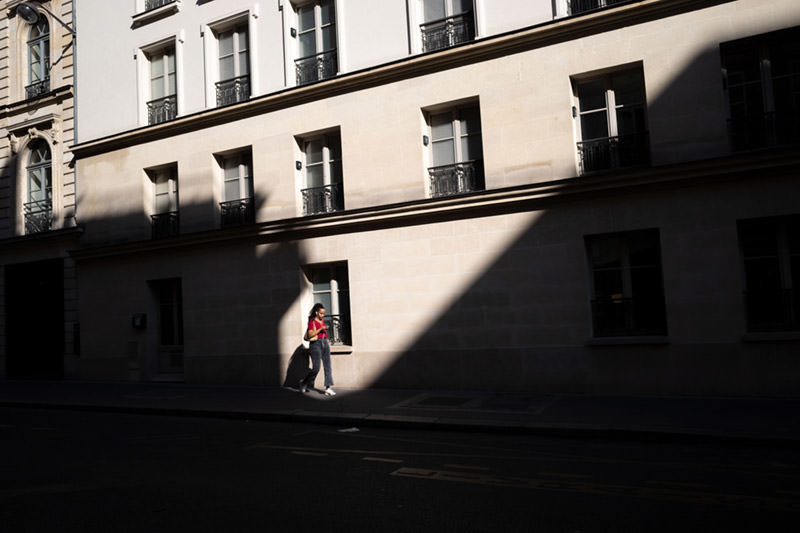
The camera settings I typically use to get a proper exposure with the Ricoh GR III are f/5.6, 1/1000, auto ISO. This is with the 28mm equivalent lens, and outdoors with cloud coverage or sunlight. The aperture of f/5.6 gives you enough depth of field, the shutter speed of 1/1000 is fast enough to freeze the moving subject, and auto ISO helps complete the exposure as the lighting scenario changes. If you’re shooting in a dark alley you might have to adjust the shutter speed to 1/250 to keep the ISO low, but this means the subject can’t be moving as fast.
In this next up-close photo, you can see how the woman in the foreground is slightly blurry and the woman in the background is in focus. Since the Ricoh GR III has a wide lens, the depth of field still allows the image to work because both subjects can be identified. If the camera were focused on the woman in the foreground, the woman in the background would be blurred out.
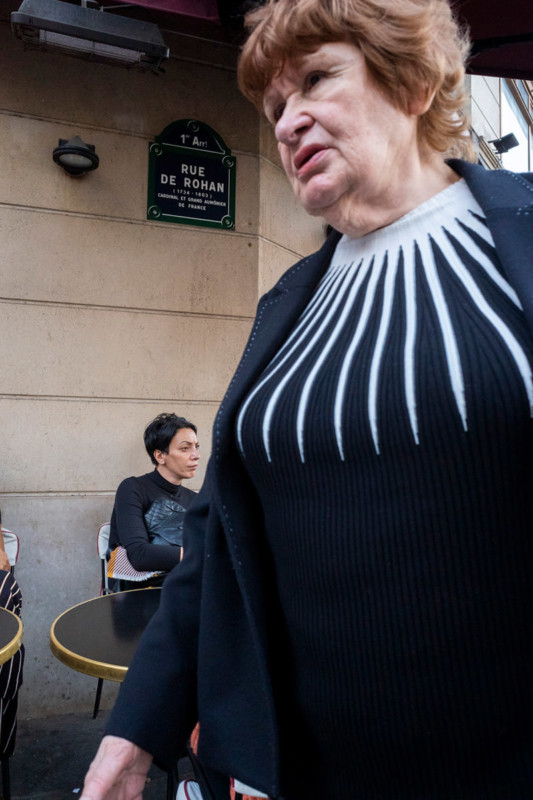
Be sure to turn off your LCD because you won’t be using it and you can save battery life. Nothing is more frustrating than running out of batteries halfway through your street session. Put the shutter drive on burst mode instead of single shot. Doing this will increase your chances of capturing a nice sequence. We’ll cover more on sequences soon.
Chimping
As you venture out into the day with your camera, be sure not to continually check the photos you capture (a.k.a. chimping). It’s a smart idea to double-check your settings for the first few photos, but to stand there in the street and look at each image can ruin the fun. You can even get discouraged and ruin the thrill of the hunt if you see an interesting subject, shoot a sequence, chimp, then realize you missed the shot.
That’s what happened for this next shot. I chimped shortly after I took it and realizing that I cut off a head was a major let down.
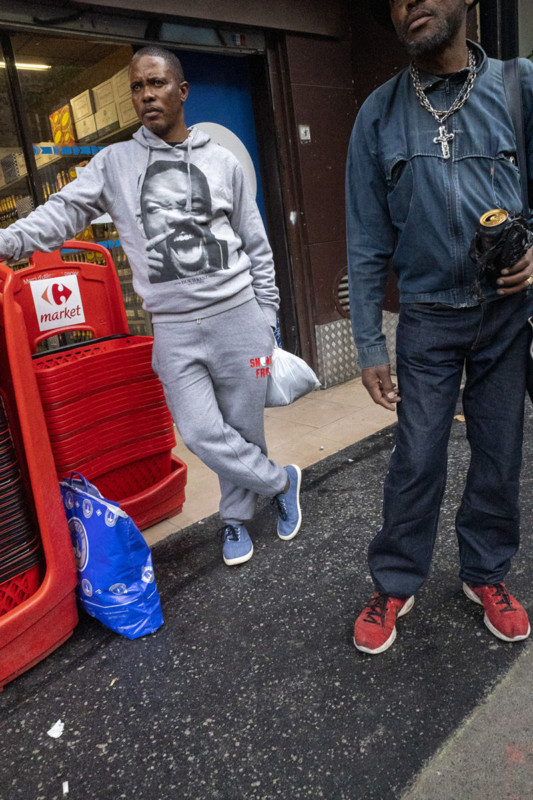
When you chimp, you also waste battery life, something you definitely want to preserve with the Ricoh GR III and most compact cameras. Additionally, you will most likely allow a great shot to pass you by if you’re constantly chimping during your session.
Just save the instant gratification for later, and enjoy yourself in the moment; unlike the bored couple in this next photo.
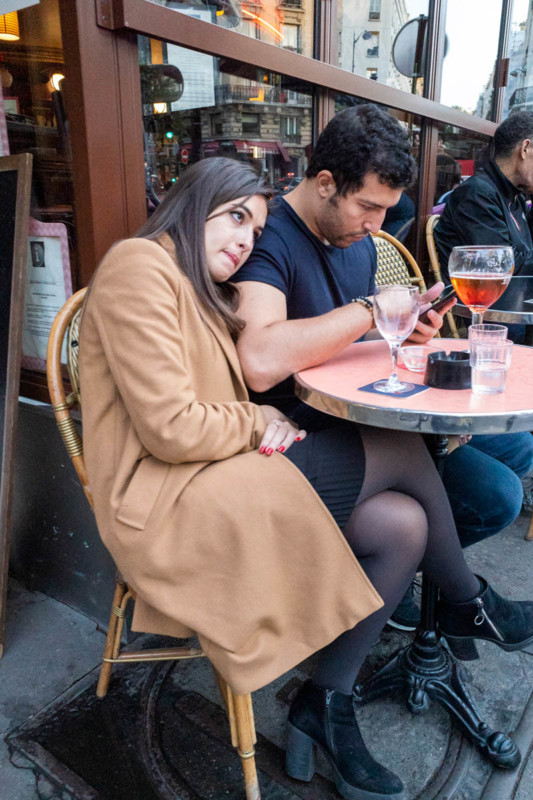
Hand Positions
There are two main hand positions you can use to capture subjects all around you. If you’re right-handed you’d hold the camera on your right side pointing outward to the right, with your arm relaxing (if you’re left-handed just do the opposite). This will capture subjects in front and to the right of you. There’s a diagram to follow.
Note: As you walk with the camera by your side you’ll be creating movement with your stride, so just be mindful of this and try to hold your arm more still. Just don’t look too awkward or robotic because that might clue people in on your intentions. Just be as subtle as you can be.
In this same position, you can even walk past someone and twist your wrist backward and tilt the camera up. That’s how I got this next shot.

The other way to hold the camera right-handed is to position it at hip level, arm bent, and pointing towards your left. This will capture subjects in front of you and on the left side. In both positions, just twist your wrist forward to capture the subjects in front of you. Here’s a quick diagram showing the different hand positions.
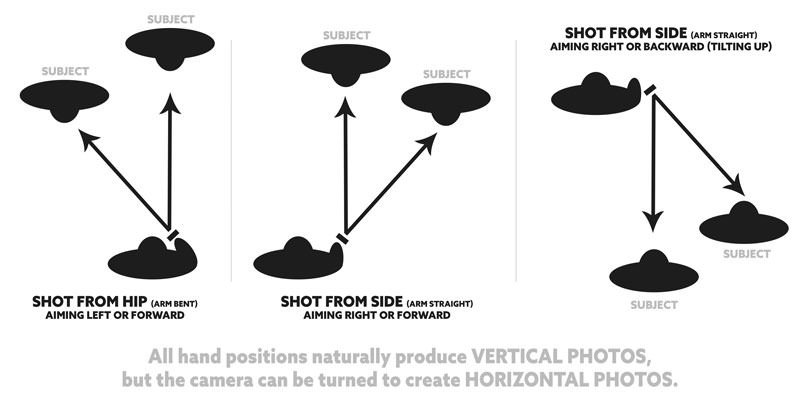
This mirror shot will show you how I’m holding the camera by my side and turning it forward.

Both hand positions naturally produce vertical photos, but the camera can be turned to create horizontal ones. It just looks more obvious when you do it this way. You’ll notice that most of the photos here are vertical, which makes it possible to capture the full body of the subject.
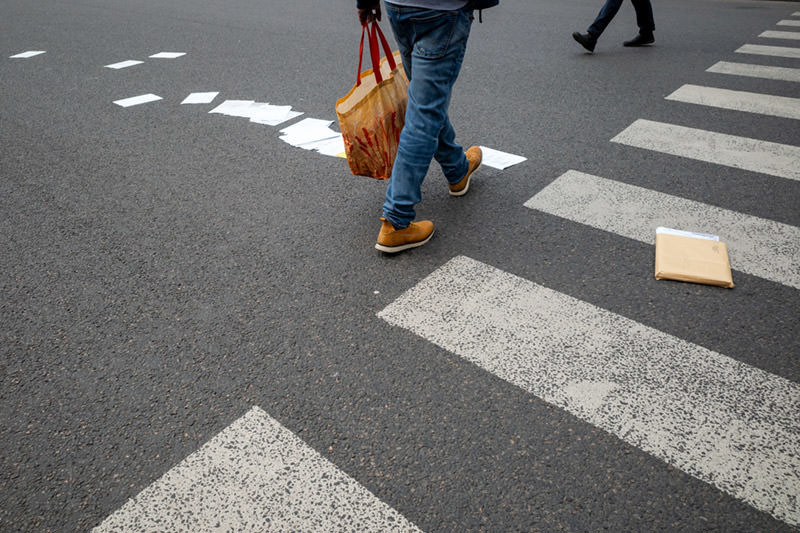
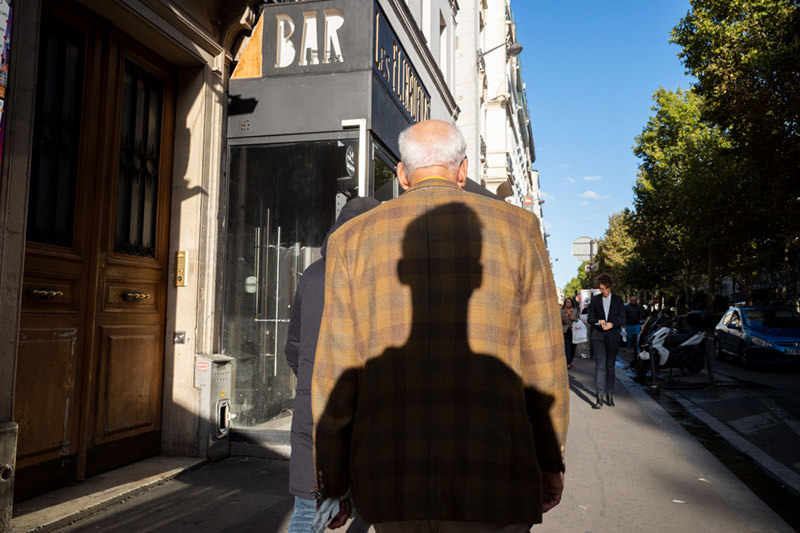
Interesting Perspectives
As you walk around, be sure to notice the buildings above you, clouds, trees, anything that you typically might have overlooked while typically shooting through the viewfinder. These higher objects will be prominent elements of your composition, which is great because it adds an interesting perspective to the final design. If you like the clouds above, just get closer to the subject and tilt your camera upward more.
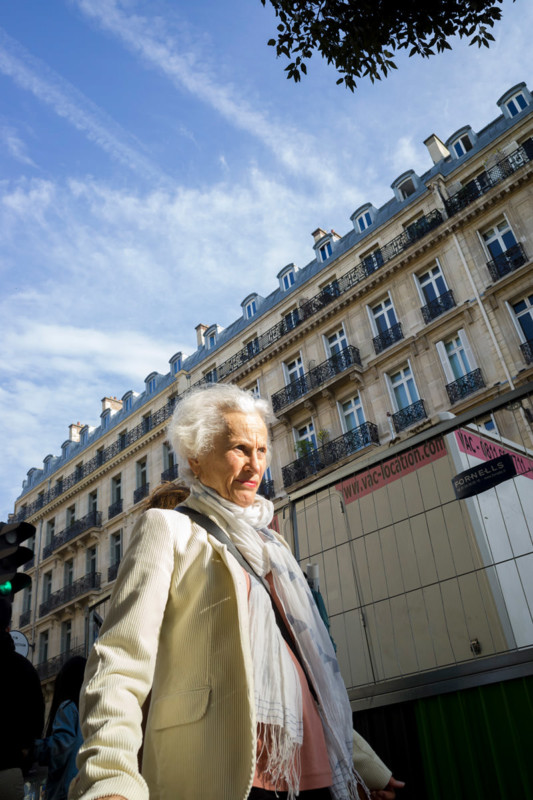
You’ll have to do an extreme tilt upwards with high subjects like this young girl chowing down riding on her dad’s shoulders.

You can do a tilt downward for subjects like dogs, or this yellow puddle splash and foot. Most likely dog urine, yeesh!
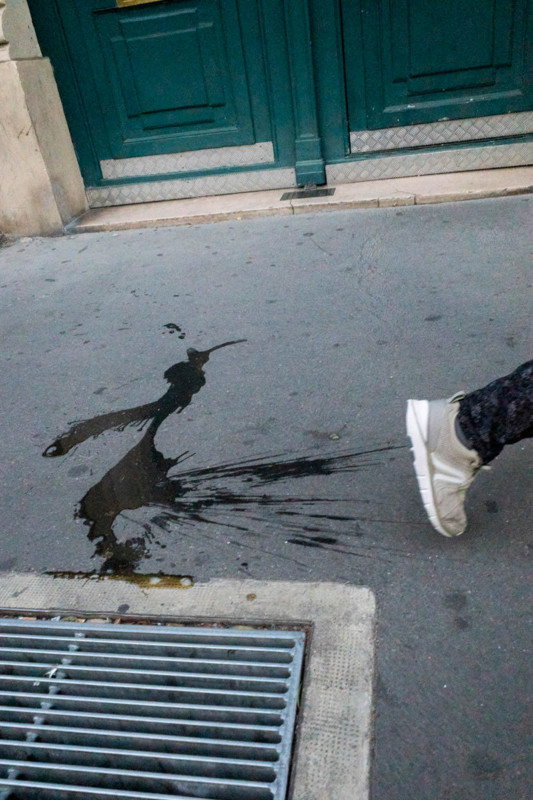
Scouting Your Subject
Always be on the lookout for whatever interests you in the people you see in the streets. Scan the crowds for this specific interest constantly and once you see it, try to position yourself in the correct place. Sometimes you can walk towards them, then cut in front of them to get a better position. We can see that in this next photo.
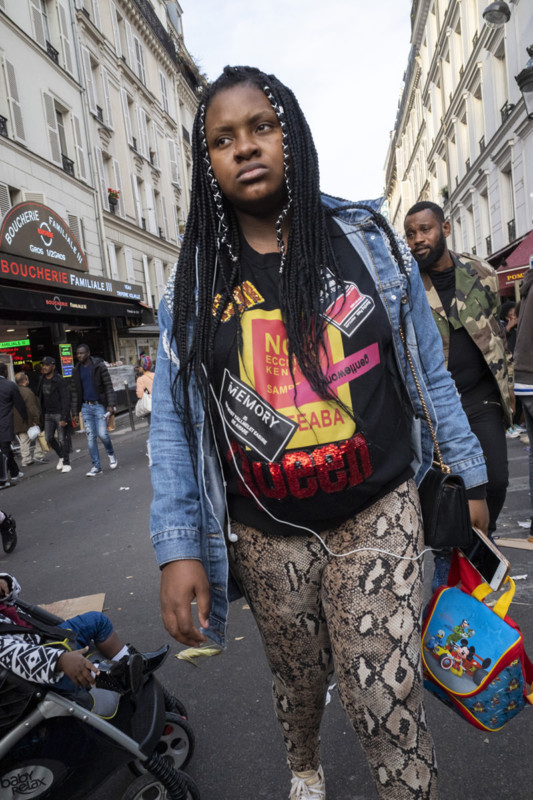
Or this one, where I’m coming straight at the subject, then cutting in front. The things that interested me in this one was the fashion, the colors of the scene, and the father leading his child through the crowded streets.

Sometimes you’ll get lucky enough to identify a juxtaposition, where the subjects in the foreground and background are united.
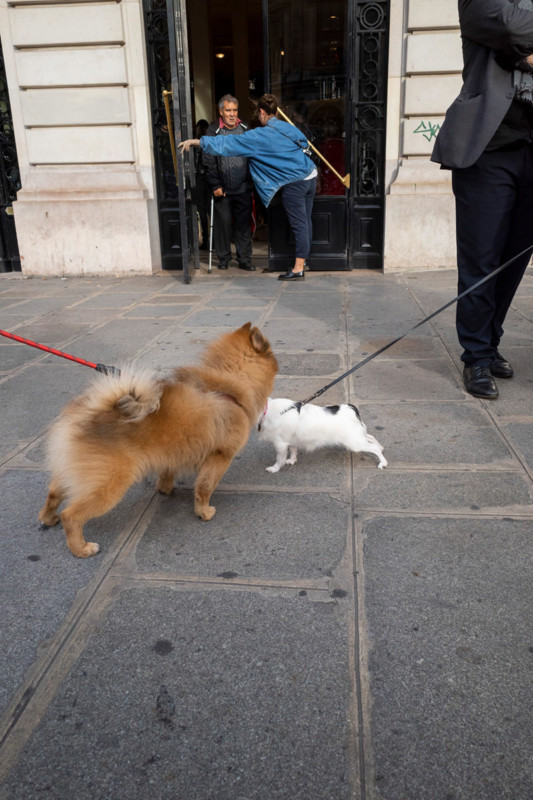
Capturing Sequences
What are we doing, “spray-and-pray” photos now? Not really because the intentions are more focused than that. We know what we want, we’re hunting for it, we’re positioning ourselves and the camera in the appropriate spot, looking above and below for design elements, thinking about diagonals, colors, gestures, the decisive moment, tons of stuff. The burst mode setting for your camera is just another tool we can use, like the LCD or auto white balance, to capture the image as we hope.
Know your camera. Some cameras can’t process a burst of RAW images very fast (buffering), so if you’re always exhausting your camera, you’re bound to miss a more interesting subject after the first burst. Your camera won’t be able to keep up if you’re holding down the shutter button three subjects in a row, so be selective.
To capture a decent sequence as you walk past someone, try not to follow them by turning your wrist; at least not until you get the feel of shooting from the hip. Your hand-eye coordination probably won’t be as good as you hope, no matter how many video games you’ve played, so it usually makes you miss more photos than anything.
Instead, aim the camera in their direction, about 45 degrees from center, and hold down the shutter button as you pass by. This was diagrammed above in the “hand position” section. A simple wrist or body twist works when you’re standing still and the subject moves past you. You’ll find what works for your own process as you continue to practice and analyze your photos. Make lots of mistakes so you can learn from them!
In this next sequence, I noticed the pretty girl with a cute dog in her purse. I aimed the camera, tapped my shutter button to focus, then held it down as we passed each other. You can see how the focus gets softer as she gets closer, but with the wide-angle lens and aperture of f/5.6, it doesn’t really matter (opinions on perfect focus vary though). You can play around with different focus settings, but I find the center focus best for my style in busy environments. Also, I welcome a little inconsistency when it comes focus.
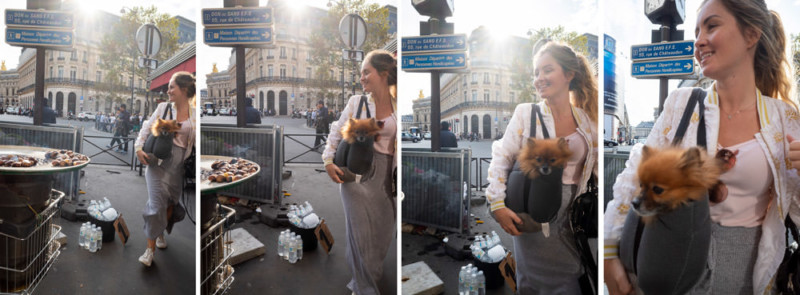
This is the image I selected from the sequence. The lens flare adds a nice sense of atmosphere (see aerial perspective), while the balance and proximity to the subject seem to work better than the others.
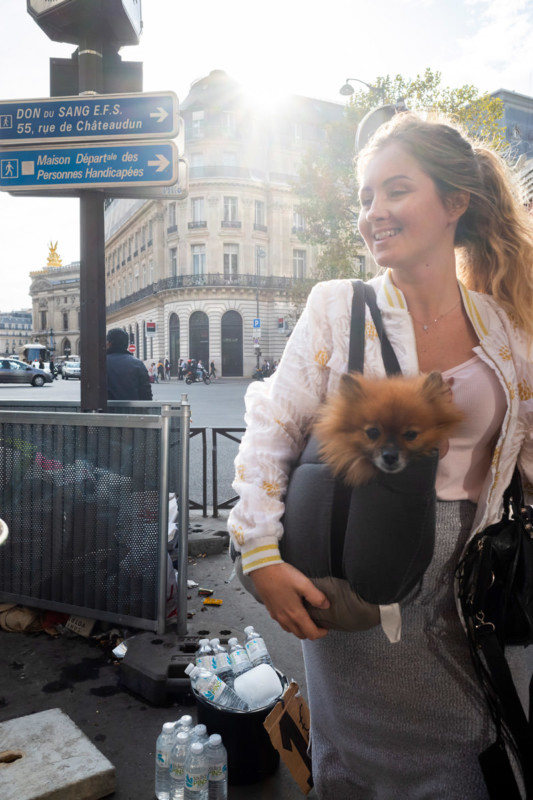
Here’s another one where I noticed the two ladies talking and was able to capture a nice sequence.
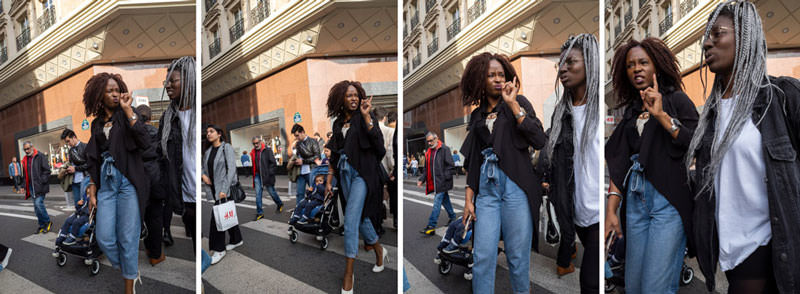
In this case, the last image works best because it still has the gesture, facial expression, and fills the frame more.
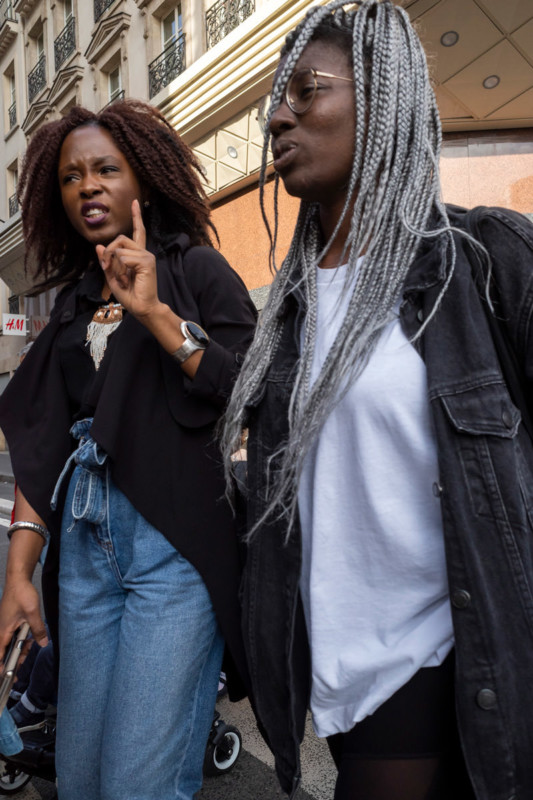
Sorting and Selecting the Best
Sorting through the junk images is the best learning experience. The disappointment of missing a sequence also helps you learn from mistakes. As you capture photos on the walk to work or to the grocery store, try and sort them on the same day. Get home, transfer the files, then go through and rate them 1-5 stars. This is what I do in Adobe Bridge. Sorting and rating photos will make you incrementally get better because you’re making note of areas you can approve; tilt up more, hold the camera more steady, double-check your settings, etc.
Within each sequence, you’ll have maybe four images of the subject, but only one will be better than the rest. Sometimes it’s not easy to select the best either. This is when knowledge of composition and design techniques comes in handy. Base your ratings and selections on things like balance, nice figure-ground relationship, gestures, dominant diagonals, dynamic symmetry, story, lighting, filling the frame/grid, etc.
In this next sequence, can you see how the image on the left has her camera/arm overlapped onto the building in the background, while the image on the right has her right shoulder going out of the frame? Only the one in the middle has a nice figure-ground relationship, where she fits nicely into the background. Almost like a puzzle piece, or a pocket of negative space. Look for slight differences like this in your sequences and you’ll surely pick the best image.
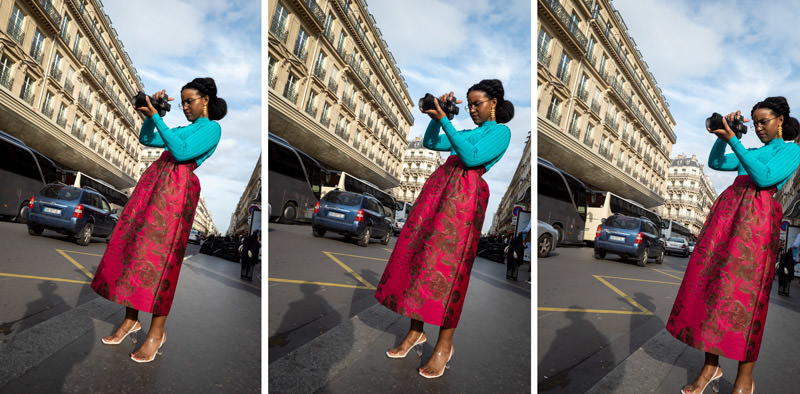
When it comes to nice lighting, try to know your environment. In Paris, it was cloudy most of the day, but then the sun would pop out around 4pm-6pm. This allows you to capture the subject in beautiful ways with rim light, shadows, bright orange faces, etc.
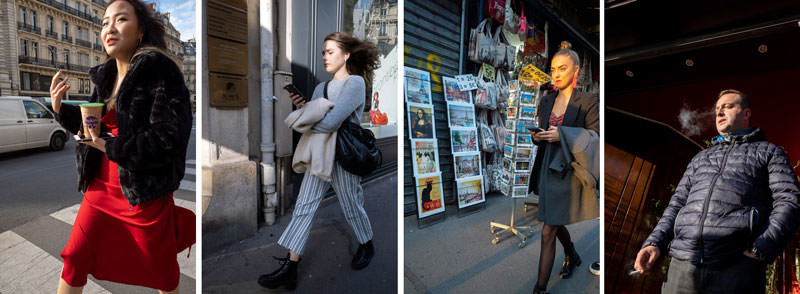
Bright and interesting colors always make for great additions to an interesting subject, and we can see various combinations in these next photos.
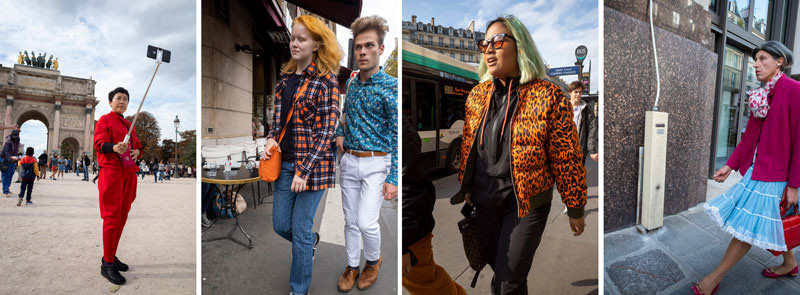
Conclusion
Are you feeling inspired to try and shoot from the hip during your next street photography session? Give it a try! Add some yin to your yang. Use your knowledge of composition and design techniques to guide you as you hunt for your subject, and also as you sort the cream of the crop. Avoid chimping, and know your environment.
Thanks so much for joining in, see you next time!
About the author: Tavis Leaf Glover is a fine art photographer and author based in Honolulu, Hawaii. The opinions expressed in this article are solely those of the author. You can find more of his work on his website, Flickr, Instagram, and Facebook. Glover is also an educator about applying Gestalt psychology principles to photography and art. This article was also published here.